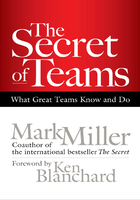Few changes in business have been so well received yet so problematic as the movement to create empowered, employee-driven work environments. Empowerment offers the potential for tapping into a wellspring of underutilized human capacity that must be harnessed if organizations are to survive in today's increasingly complex and dynamic world.
Empowered employees benefit the organization and themselves. They have a greater sense of purpose in their jobs and lives, and their involvement translates directly into continuous improvement in the workplace systems and processes. In an empowered organization, employees bring their best ideas and initiatives to the workplace with a sense of excitement, ownership, and pride. In addition, they act with responsibility and put the best interests of the organization first.
The traditional management model of the manager in control and employees under control is no longer effective. To create an empowered workplace, management's role in organizations must move from a command-and-control mind-set to a responsibility-oriented and supportive environment in which all employees have the opportunity to do their best.
Shifting to an empowerment philosophy calls for changes in most aspects of an organization. Both managers and employees must learn, first, not to be bureaucratic and, second, to be empowered. Unfortunately, many managers do not understand that empowerment involves releasing the power people already have, nor do they understand how to navigate the journey to empowerment.
Empowerment Takes More Than a Minute is a how-to book that guides readers step-by-step through one manager's struggle to discover the three essential keys to empowerment. By following the manager's odyssey to the Land of Empowerment, readers discover that they can take the same journey, which, like any heroic journey, is filled with paradox, challenge, and fitful stops and starts. Empowerment Takes More Than a Minute provides practical and simple concepts that CEOs, COOs, CIOs, and managers and employees at all levels in organizations both public and private can apply to their particular situations.
Though many managers have dismissed empowerment as another passing gimmick, we find that people in organizations are naturally attracted to the idea of enhanced involvement at all levels. Also, we personally have seen organizations succeed with empowerment. For more than fifteen years, we have worked extensively with a wide variety of domestic and multinational companies that were trying to create empowered workplaces. These companies have taught us a great deal about what empowerment is and how to create it. They haven't always known the answers to the questions raised by empowerment, and neither have we. Quite the contrary, it has been through missteps that we have learned the three keys to empowerment presented in this book.
In this second edition to Empowerment Takes More Than a Minute, we provide a new introduction that explains how empowerment has moved beyond the fad stage and become essential for effective organizations in today's dynamic and complex world. We have also updated the text and characters for today's technologically sophisticated business world. Finally, we added an epilogue that reinforces the difficulty of moving to empowerment and suggests some tools to help managers and team members succeed in the journey.
Empowerment is definitely achievable, but the journey is not for the weak in spirit. For those of you who undertake it, we urge you to stay the course. We know that your path can be made easier if you start with and stick to the three keys of empowerment explained in Empowerment Takes More Than a Minute.
Good luck on your journey.
Ken Blanchard John Carlos Alan Randolph Fall 2001
第4章 Introduction to the Second Edition
One of the joys of writing a business best-seller is the feedback and validation you receive for the messages in the book. Unfortunately, one of the problems with writing about empowerment is that too many organizations have dismissed it as a fad that cannot be of much help in today's high-technology business world.
We disagree and believe that, if anything, empowerment is even more necessary today than it was in the past. While information technology and the internet have opened global doors and allowed for rapid response to the market, they have also raised the bar for success and effectiveness. As numerous business failures have proven, slick ideas and revenue generation do not guarantee company success. Unless the innovative ideas are significant and costs can simultaneously be controlled, a company's existence will be short-lived.
Doing business today means succeeding in a world that is increasingly complex and more dynamic. The global economy offers access to many new markets, but it also demands an understanding of cultural differences and a constant vigilance for competition that can come from anywhere in the world. The technological environment of business makes it increasingly easy to change products, services, pricing, and advertising strategies but at the same time affords the opportunity for compounding errors at a dizzying pace. Couple these factors with the diversity of the workforce and the marketplace, the call for environmental responsibility, the stress on ethical behaviors, and the rapid changes in politics and economics throughout the world, and you have a business environment that demands better utilization of the human magnificence that lies in wait in every organization.
Too many business leaders give lip service to human talent as the underutilized asset in their companies, while they continue to look for answers in technology and spreadsheets. We would encourage business leaders to add to their list of solutions the wealth of talent that lies in their people. Indeed, empowerment relies on an explicit recognition that people in organizations have tremendous power in their experience, knowledge, and internal motivation. When this power is released and directed toward the challenges businesses face, it is truly astonishing the results that can be achieved. Empowered organizations are filled with engaged, involved people who can greatly help in achieving flexibility, customer responsiveness, innovation, and financial success in a challenging and competitive business environment. We believe empowerment is the key to integrating technology, financial acumen, and human innovation.
As numerous companies have found, empowerment is not flawed. Yes, some successful leaders call it entrepreneurship, some call it ownership, some call it engagement, and some simply call it involvement. But the common theme is that they recognize the need to release the knowledge, experience and motivation power within people for astonishing results.
Granted, empowerment can be a difficult concept to appreciate fully—and even more difficult to implement. Too many business leaders think that the journey to empowerment should be quick and easy. All management has to do is give it a nudge, and employees will jump on the opportunity. Unfortunately, changing the history and assumptions in people and organizations is much more challenging. What we knew before writing the first edition of this book and what has been confirmed by numerous readers, worldwide, is that the change to empowerment is hard!
But it is certainly possible. We have been encouraged to find a number of organizations that have made empowerment part of their culture.
For example, one specialty retail food company, Trader Joe's, has made significant strides toward creating a culture of empowerment. By giving people more information, greater autonomy, and more responsibility, they have been able to utilize the collective power in their people to achieve annual sales growth exceeding 26 percent. Sales per store increased by 10 percent per year while the number of stores increased by almost 100 percent, and overall sales increased in excess of 500 percent over an eight-year period. Their president, John Shields, said it well: “You can't successfully run stores spread over a growing number of states without empowered employees.”
And a surprising organization that has made real progress with empowerment is the Collections Division of the Los Angeles Field Office of the IRS— yes, the IRS. And if they can do it, certainly your organization can, too. By recognizing the talents of all staff and stressing a message of service, they have focused the efforts of the entire staff. The management team of Art Hylton, Steve Jensen, and Rich Morgante conducted a series of twelve town hall meetings to share the message that everyone had to look at his or her own behavior first. By conducting a service assessment and discussing the results, the leaders reduced the existing “we-they” attitude and provided a target on which everyone, working in teams, could focus. Their journey is still in progress, but the results so far suggest they may just make it to the Land of Empowerment. We wish them well in their continued efforts.
By Sharing Information, Declaring the Boundaries for Autonomy, and Creating Self-Managed Teams, these organizations and many others have made substantial progress toward empowerment and toward addressing the challenges of doing business today. We want to challenge all companies and their leaders to make the same commitment to empowerment.
To ignore empowerment is not simply to ignore a fad. It is to ignore the very tools that may make your organization successful today and into the future.
We hope that you will read this book with these thoughts in mind and that if you are serious about making the journey, you will use as a guide our second book, The Three Keys to Empowerment: Release the Power within People for Astonishing Results (1999). You may also find useful for teams in your organization the ten-part discussion guide titled Power Up for Team Results (2000) (both the book and booklets are published by Berrett-Koehler in San Francisco).
We know that the challenges of changing to empowerment are many and that the journey is difficult, but we also know that the results at the end are more than worth the effort—higher quality, better service, more competitiveness, lower costs, greater flexibility in addressing customer needs, and people who feel engaged and magnificent.
So we wish you the conviction to work toward empowerment, and we hope that along the way you will enjoy the process of change. Empowerment is a beautiful place to be, and the process of getting there is filled not only with challenges but also with many rewards. Enjoy and empower!
Ken Blanchard John Carlos Alan Randolph Fall 2001















